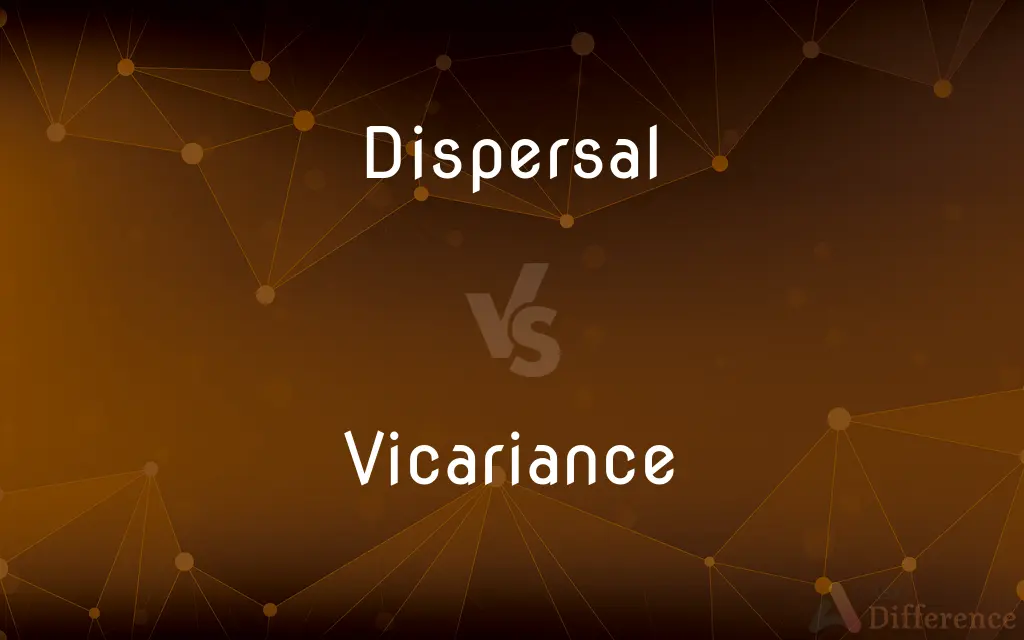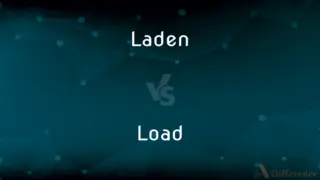Dispersal vs. Vicariance — What's the Difference?
By Maham Liaqat & Urooj Arif — Updated on March 20, 2024
Dispersal involves organisms moving from one location to another, while vicariance is the separation of populations due to geographical barriers.

Difference Between Dispersal and Vicariance
Table of Contents
ADVERTISEMENT
Key Differences
Dispersal is an ecological process where organisms move or are transported away from their original habitats to new areas, often influencing gene flow and species distribution. Vicariance, on the other hand, occurs when a population is divided by a new geographical barrier, leading to the separation of species into distinct groups without physical movement.
Dispersal can be active, with organisms intentionally moving, or passive, where they are transported by wind, water, or other animals. This process can lead to colonization of new areas, adaptation, and potentially speciation. Vicariance typically involves environmental changes such as the formation of mountains, rivers, or climatic shifts, creating barriers that isolate populations and promote divergent evolution.
The concept of dispersal is often associated with the ability of species to expand their range and adapt to new environments, contributing to biodiversity. Vicariance, by contrast, emphasizes how historical geological and climatic events have shaped the distribution of species by isolating populations and leading to independent evolutionary paths.
Both dispersal and vicariance are crucial in biogeography, the study of the distribution of species and ecosystems. Dispersal explains how species come to inhabit new areas, while vicariance accounts for the patterns of separation and divergence within species due to geological or climatic barriers.
In conservation biology, understanding dispersal is key to predicting how species might respond to environmental changes and habitat fragmentation, whereas studying vicariance helps explain the historical distribution of biodiversity and can inform conservation priorities based on evolutionary history.
ADVERTISEMENT
Comparison Chart
Definition
Movement of organisms from one location to another.
Division of populations by geographical barriers.
Mechanism
Active movement or passive transport.
Formation of physical barriers due to geological or climatic changes.
Outcome
Colonization of new areas, gene flow, potential speciation.
Isolation of populations, divergent evolution, speciation.
Associated with
Adaptation to new environments, range expansion.
Historical distribution patterns, evolutionary divergence.
Relevance
Key in predicting responses to environmental changes and habitat fragmentation.
Important for understanding historical biodiversity patterns and conservation priorities.
Compare with Definitions
Dispersal
The movement of individuals or propagules away from their origin or population.
Bird dispersal to new islands can lead to the establishment of new populations.
Vicariance
Results from environmental changes like continental drift, river formation, or mountain building.
The formation of the Grand Canyon led to vicariance in local species.
Dispersal
Can occur through various vectors like wind, water, or animals.
Coconut seeds are dispersed by ocean currents to different shores.
Vicariance
Important for understanding biogeographical patterns and evolutionary processes.
Studies of vicariance help explain the unique biodiversity of Madagascar.
Dispersal
Facilitates adaptation by introducing species to new environments.
Some species disperse to new habitats to escape competition or predation.
Vicariance
The geographical separation of a population due to barrier formation.
The rise of the Himalayas created vicariance events for many Asian species.
Dispersal
Essential for the colonization and expansion of species ranges.
The dispersal of animals following the last Ice Age repopulated many areas.
Vicariance
Leads to speciation by isolating populations.
Vicariance has caused the speciation of many island species after being separated from mainland relatives.
Dispersal
Influences species distribution and genetic diversity.
Pollen dispersal by bees contributes to plant genetic diversity across landscapes.
Vicariance
Reflects the historical distribution of species due to past geological events.
Fossil records show how vicariance shaped the distribution of ancient species.
Dispersal
The act or process of dispersing or the condition of being dispersed.
Vicariance
The division of a widespread group of organisms by a geographic barrier, such as a mountain range or a body of water, often resulting in the evolution of related species on either side of the barrier.
Dispersal
The act or result of dispersing or scattering; dispersion.
Vicariance
(biology) The separation of a group of organisms by a geographic barrier, resulting in differentiation of the original group into new varieties or species.
Dispersal
A dispersal prison.
Vicariance
(geology) The geological event which produces such a barrier (volcano, earthquake, etc)
Dispersal
The act or result of dispersing or scattering; dispersion.
Vicariance
The act of experiencing an event by proxy through an empathic link with the person who is experiencing the event firsthand.
Dispersal
The act of dispersing or diffusing something;
The dispersion of the troops
The diffusion of knowledge
Common Curiosities
Can human activities cause dispersal?
Yes, human activities like habitat fragmentation, transportation, and climate change can facilitate or force dispersal of species to new areas.
What triggers dispersal in organisms?
Dispersal can be triggered by factors like resource competition, predation pressure, or environmental changes, driving organisms to seek new habitats.
How does vicariance lead to speciation?
Vicariance isolates populations, limiting gene flow and allowing for divergent evolution under different environmental pressures, which can lead to speciation.
Can vicariance result from human-induced changes?
While typically natural, human-induced changes like the construction of dams or roads can create barriers that lead to vicariance-like effects.
How do dispersal and vicariance contribute to biodiversity?
Dispersal can increase biodiversity by introducing species to new areas, while vicariance contributes by creating isolated populations that may evolve into new species.
Can organisms disperse back to their original habitats?
While possible, dispersal is generally a one-way movement, but some species may exhibit return or cyclic movements as part of their life cycle.
What are examples of barriers causing vicariance?
Barriers can include physical features like mountains, rivers, oceans, or climatic shifts that alter habitats and isolate populations.
Why is understanding vicariance important for conservation?
Understanding vicariance helps identify regions of unique evolutionary history and biodiversity, guiding conservation priorities and actions.
How is vicariance different from habitat fragmentation?
Vicariance is a natural process often resulting from large-scale geological or climatic changes, while habitat fragmentation is usually a result of human activities.
How do scientists study dispersal and vicariance?
Studies involve genetic analyses, fossil records, and modeling of ecological and geological changes to understand the patterns and processes.
Can vicariance affect aquatic species?
Yes, aquatic species can be affected by vicariance due to changes in water bodies, currents, or the emergence of land masses.
What role does dispersal play in invasive species spread?
Dispersal mechanisms are key in the spread of invasive species, which can outcompete native species and disrupt ecosystems.
How do climate change impacts relate to dispersal and vicariance?
Climate change can alter habitats and create new barriers, affecting dispersal routes and leading to new vicariance events, reshaping species distributions.
How do dispersal abilities vary among species?
Dispersal abilities vary widely, with some species capable of long-distance travel, while others are more restricted, influencing their distribution and adaptation.
How do dispersal and vicariance affect island biogeography?
These processes are central to island biogeography, explaining the unique species compositions and evolutionary paths of island populations.
Share Your Discovery

Previous Comparison
Laden vs. Load
Next Comparison
Clean vs. NeetAuthor Spotlight
Written by
Maham LiaqatCo-written by
Urooj ArifUrooj is a skilled content writer at Ask Difference, known for her exceptional ability to simplify complex topics into engaging and informative content. With a passion for research and a flair for clear, concise writing, she consistently delivers articles that resonate with our diverse audience.














































